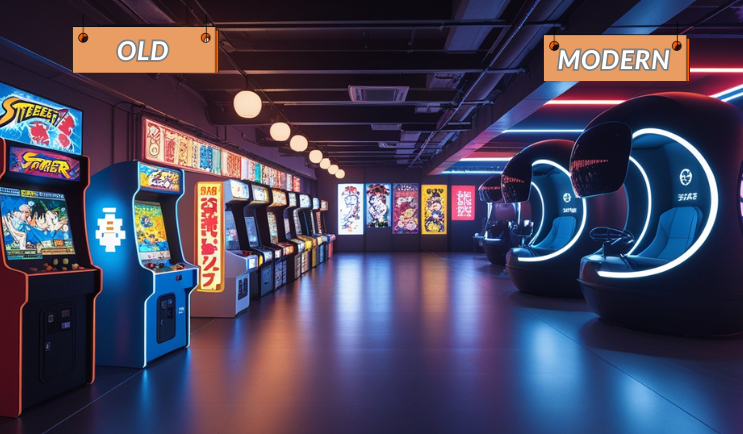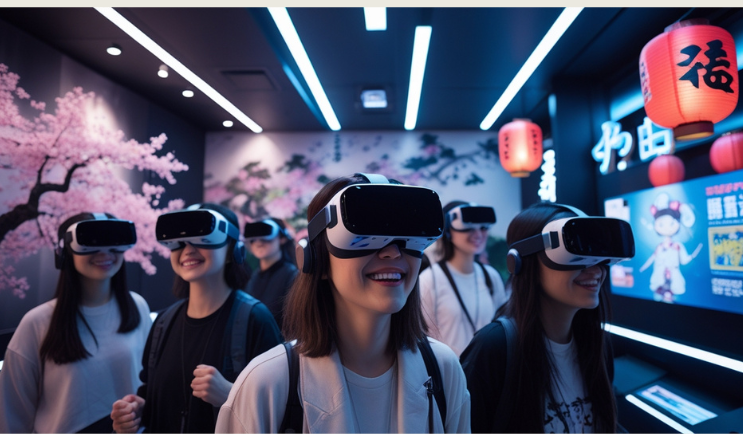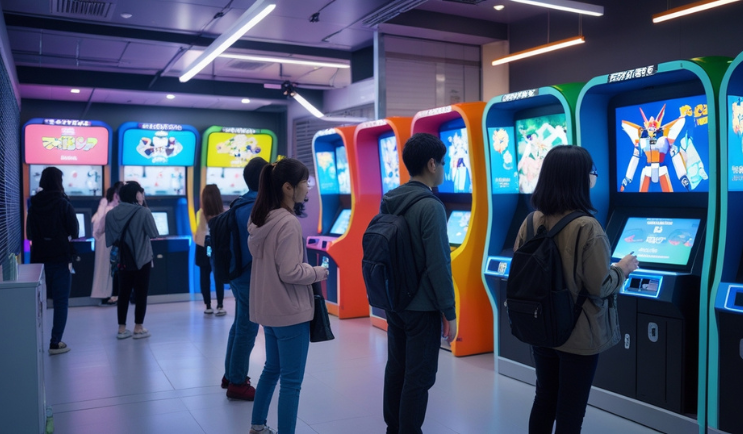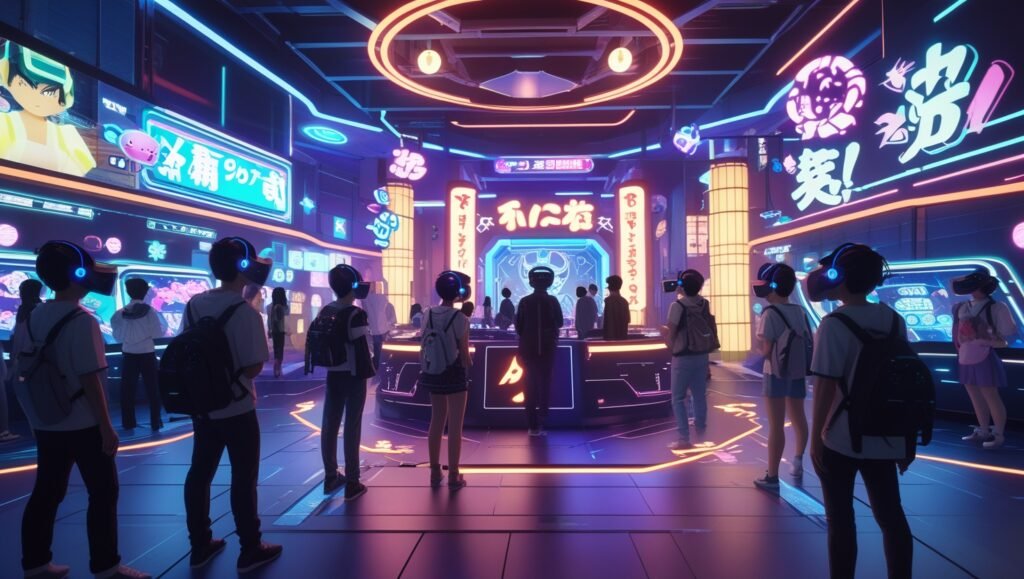Japan has long been a pioneer in the gaming world, but now the country is taking entertainment to new dimensions through virtual reality arcades. These innovative spaces are transforming how people experience games and creating unique social experiences that can’t be replicated at home. Virtual reality theme parks across Japan are pioneering a new type of location-based entertainment and testing the boundaries of virtual human experiences.
Table of Contents
ToggleThe integration of VR into Japanese arcade culture builds on decades of gaming tradition. Facilities like Namco Wonder Egg and VR Zone Shinjuku in Tokyo have become destinations where friends gather to try experiences impossible to replicate on home systems. These high-tech venues feature everything from virtual roller coasters to interactive fantasy worlds where players can battle monsters together.
The success of these VR entertainment centers is closely tied to Japan’s deeply rooted gaming culture. Even major events like the Tokyo Game Show have embraced virtual venues – creating digital maritime fortresses and floating watchtowers in the sky where gamers can connect. This fusion of traditional arcade entertainment with cutting-edge technology represents not just a business opportunity but a cultural evolution in how Japanese society experiences play.
Evolution of Japanese Entertainment

Japan’s entertainment landscape has undergone remarkable transformation over decades, moving from physical arcade spaces to cutting-edge virtual experiences. This evolution reflects both technological advancement and deep cultural shifts in how Japanese society embraces gaming and interactive media.
History of Gaming Arcades in Japan
The Japanese arcade industry began flourishing in the late 1970s, growing alongside the emergence of electronic entertainment. These gaming centers, known locally as “game centers,” quickly became cultural hubs in urban Japan.
By the 1980s and 1990s, arcades had transformed into social gathering spaces where players competed and formed communities. Games like Street Fighter and Initial D attracted dedicated followings across generations.
Even when home consoles gained popularity, Japanese arcades remained critical laboratories for testing new gaming technology and concepts. Many innovations that later appeared in home systems were first tested in these spaces.
Arcades fostered a unique gaming culture that influenced many aspects of Japanese entertainment, including anime and manga that frequently featured arcade settings and gaming competitions.
The Rise of Virtual Reality
Virtual reality represents the latest chapter in Japan’s gaming evolution. Since 2016, VR technology has transformed entertainment spaces across the country, creating new immersive experiences beyond traditional gaming.
Japanese companies have been at the forefront of developing cutting-edge VR experiences that appeal to both local and international audiences. These technologies blend Japan’s gaming expertise with its storytelling traditions.
VR theme parks have emerged as a significant trend, with specialized venues in Tokyo, Osaka, and other major cities pioneering location-based VR entertainment. These spaces offer experiences impossible to recreate at home.
The integration of anime and manga franchises into VR experiences has created uniquely Japanese entertainment options that showcase the country’s cultural strengths while pushing technological boundaries.
Virtual Reality Technology in Gaming Arcades
Japan stands at the forefront of VR arcade innovation, creating spaces where players can experience digital worlds with unprecedented realism. These specialized venues offer technology and experiences far beyond what’s available in home VR setups.
Cutting-Edge VR Experiences
Japanese VR arcades feature state-of-the-art equipment that transforms how people play games and interact with digital environments. Bandai Namco’s VR Zone Shinjuku represents the pinnacle of these advancements, offering experiences impossible to replicate at home.
Many arcades employ full-body tracking systems, allowing players to see their entire bodies represented in virtual space. This technology enables more natural movement and interaction within game worlds.
High-end headsets with wider fields of view and sharper resolutions create visuals that blur the line between reality and fantasy. Some venues even incorporate temperature changes, wind effects, and scent dispensers to stimulate all senses.
Wonder Egg by Namco pioneered these concepts, showing how dedicated spaces could transform gaming experiences long before home VR became viable.
Innovations in Interactivity and Immersion
Japanese VR arcades excel at creating shared experiences where multiple players can interact within the same virtual space. This social dimension adds depth that solo VR often lacks.
Specialized controllers simulate real-world objects with remarkable accuracy. Players might grip a physical sword that perfectly matches its virtual counterpart or feel the kickback of a virtual gun through haptic feedback.
The Adores VR Park in Tokyo showcases how these venues can dedicate entire rooms to single experiences, allowing freedom of movement impossible in limited home spaces.
Many arcades feature rotating installations of media art and experimental video works that push boundaries beyond gaming. These installations encourage visitors to explore and interact with virtual environments in new ways.
Japanese developers continue pushing VR arcade technology forward, recognizing that social VR experiences will likely remain more compelling in dedicated spaces than in living rooms for years to come.
Cultural and Social Impact

Japan’s video game and VR arcade scene has profoundly shaped the nation’s entertainment landscape, weaving itself into the cultural fabric while transforming physical spaces in innovative ways.
Integrating Video Games with Japanese Culture
Video games in Japan have evolved beyond mere entertainment to become a modern-day ritual blending art and psychology. This integration is particularly visible in Tokyo’s entertainment districts like Akihabara and Shinjuku, where gaming culture flourishes alongside anime and manga.
Characters like Super Mario have transcended their digital origins to become cultural ambassadors for Japan globally. Many VR experiences now incorporate elements from traditional Japanese mythology and storytelling techniques.
The influence works both ways – Japanese cultural elements such as cherry blossoms, yokai (spirits), and historical periods regularly appear in game designs. In Akihabara, the legacy of arcade and console games is celebrated openly, creating spaces where gamers are praised rather than marginalized.
Architecture and Design in VR Arcades
Japanese VR arcades feature distinctive architectural elements that set them apart from their Western counterparts. Designers often create immersive environments before players even don their headsets.
Many facilities in Tokyo feature sleek, futuristic aesthetics with neon lighting and minimalist designs that echo Japan’s cyberpunk influences. Space efficiency is paramount, with clever solutions allowing maximum experiences in limited square footage.
Large-scale VR attractions have emerged in Shinjuku, offering warehouse-sized zones where players can move freely through virtual worlds. These spaces often incorporate elements from popular anime and manga series in their physical design.
Temperature control, sound insulation, and specialized flooring are meticulously engineered for safety and immersion. The attention to detail extends to waiting areas, which often feature themed decorations and smaller gaming options to entertain customers before their main VR experience begins.
Navigating the Modern VR Arcade Scene

Japan’s VR arcade scene offers immersive experiences that blend cutting-edge technology with unique cultural elements. Visitors can enjoy everything from giant robots to fantasy adventures without needing personal VR equipment.
Essential Info for Tourists and Locals
VR arcades in Japan, particularly in Tokyo, typically require advance reservations for popular experiences. Prices range from ¥1,000-¥3,000 per experience, with package deals available at most locations.
Mazaria in Ikebukuro and VR Zone in Shinjuku stand out as premier destinations, featuring exclusive titles like Evangelion and Gundam. Many interfaces offer English options, though basic Japanese phrases can be helpful.
Operating hours typically run from 10:00 AM to 10:00 PM, with peak crowds on weekends and holidays. Some arcades enforce age restrictions (13+) and height requirements for safety reasons.
Popular VR Arcade Locations in Tokyo:
- Mazaria (Ikebukuro)
- VR Zone (Shinjuku)
- Tokyo Joypolis (Odaiba)
- VR Park Tokyo (Shibuya)
Making the Most of Your Visit
First-timers should start with shorter experiences (5-10 minutes) to avoid motion sickness. Wearing comfortable clothes and avoiding heavy meals before VR sessions helps maximize enjoyment.
Many arcades feature unique Japanese cultural elements in their games, offering insights into traditions, anime culture, and futuristic visions of Japanese society. During the annual Tokyo Game Show, VR arcades often premiere new experiences.
For the best value, consider purchasing multi-experience packages rather than individual games. Most venues provide lockers for personal belongings, as VR experiences require freedom of movement.
Take breaks between intense experiences to prevent fatigue. Photography is permitted in most common areas but prohibited during gameplay to prevent accidents and distractions.
